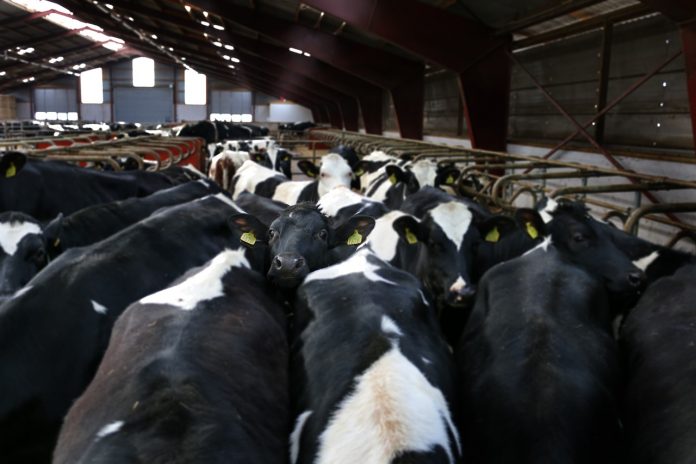We have experienced high temperatures and uncomfortable humidity recently. These conditions are especially stressful for dairy cattle. This article will discuss the effects of and tips for managing heat stress in dairy cattle.
Cows generate heat through normal activities of eating, walking and producing milk. Animals become stressed when the amount of heat produced is greater than what they can get rid of through breathing, sweating or by natural or mechanical ventilation.
Heat stress is a concern because it costs you money. Reduced feed intake, lowered milk production, poor reproduction and increased disease potential are all reasons to be concerned about the effects of heat stress on dairy cattle.
When do animal experience heat stress? Cows begin to feel heat stress at temperatures much lower than do people. Depending upon their level of production, temperatures as low as 65-72 degrees Fahrenheit can cause stress.
The table below shows the effects of the temperature-humidity index on dairy cattle stress levels.
Indicators of heat stress
In addition to air temperature as an indicator of potential heat stress, animals often exhibit signs that indicate their level of discomfort, such as physical appearance, respiration, body temperature and milk production.
Animals breathing with their mouths open and panting with an extended neck are physical signs to observe. Dairy cattle have a normal respiration rate between 40 and 60 breaths per minute. If 10% or more of the animals have a rate exceeding 100 breaths per minute, steps must be taken immediately to cool these animals.
The normal body temperature of an adult cow is between 101.5 and 102.5 degrees Fahrenheit. If more than 5% of the animals have a body temperature greater than 105 degrees Fahrenheit, this is an emergency.
Milk production declines as animals experience greater levels of heat stress. Under mild conditions, a decline of 2.5 pounds per head per day is not uncommon. Under mild to moderate conditions, a loss of six pounds per head per day can be expected and under moderate to severe heat stress, a decline of about nine pounds per day is possible. A decrease of more than 10 pounds per head per day is a life-threatening condition.
Techniques to minimize heat stress
Penn State University recommends using heat abatement techniques including shade, air and water. Shade is used to protect animals from solar radiation and may include trees, buildings, cloth or structures. If shade areas are constructed, a minimum of 12 feet in height is recommended.
Air exchange and circulation are two important considerations. Providing air exchange about every minute or less is critical for removing gases, heat, and moisture from buildings.
Mechanically ventilated buildings accomplish this with fans and inlets. Naturally ventilated buildings rely on proper building orientation and wind speed to maximize air exchange. Air circulation speeds of 3.5 to 5 miles per hour are accomplished with mechanical ventilation. The key is to use the appropriate size and number of fans strategically placed to maximize animal comfort.
Water is necessary for drinking and evaporative cooling purposes. According to Penn State University extension, water consumption by dairy animals can increase as much as 20% during hot weather.
Make certain you have adequate supplies of adequately accessible high-quality water available. Water used for evaporative cooling helps increase heat transfer from the animals.
There are two types of evaporative cooling systems: direct and indirect. The direct system periodically applies water to the animal’s skin to draw heat from the body. The indirect system reduces the air temperature around the animals to increase the rate of heat transfer.
Summary
Heat stress is a concern when managing dairy cattle during the hot and humid months of the year. If not managed, heat stress can result in animal discomfort, health concerns, reproductivity issues, reduced feed intake and poor milk production.
I encourage you to talk with your veterinarian, nutritionist, and Extension professional for additional advice in managing heat stress.













